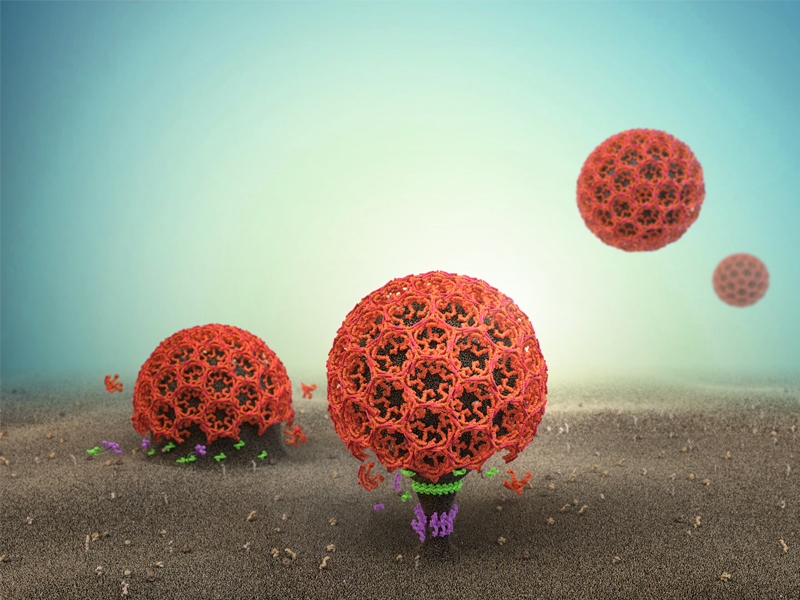Scientists at Freie Universität Berlin and the Leibniz-Forschungsinstitut für Molekulare Pharmakologie (FMP) have succeeded in revealing a key mechanism of membrane deformation. “This mechanism plays a fundamental role in cell entry of receptors and hormones and is hijacked by viruses and bacteria,” explains Professor Dr. Frank Noé, a computational scientist at Freie Unversität Berlin, who together with Professor Dr. Volker Haucke, a biochemist at the FMP, led the study. High performance computer simulations paired with super-resolution imaging and cell biological methods were the key to the discovery. The work concludes a long-standing quest to complete the understanding of the clathrin mediated endocytosis (CME) pathway and is of high biomedical and biotechnological relevance for the fight against diabetes or cancer and for the development of new antiviral drugs or antibiotics. The results were recently published in the high-ranking journal Nature Communications.
“Cells communicate with each other and their environment by receptors displayed on their surface,” explains Prof. Dr. Frank Noé. Modulating the number of a particular receptor in the cell's membrane sets the threshhold for the cell's sensitivity to the receptor ligand. Some receptors also require being taken up into the cell interior to elicit the correct signals that instruct the cellular response. “The question here is, how receptor molecules can be internalized into the cell resulting in their removal from the cell membrane,” says Dr. Volker Haucke. One possibility is to pack them together in a small membrane patch coated by the protein clathrin and then pull the patch back into the cell. This mechanism is called clathrin-mediated endocytosis (CME).
“What happens there is similar to forming a small balloon, a so-called vesicle, in the middle of a large cloth,” says the molecular pharmacologist. First, a cup needs to be formed, then the neck that connects this cup to the cell membrane has to be constricted, and finally cut off with scissors. Scientists know in great detail how molecules form the membrane cup and how scissor molecules eventually cut the neck. The scientists from Freie Universität Berlin and the Leibniz-Forschungsinstitut für Molekulare Pharmakologie now succeeded in finding the missing link: SNX9, the molecule that constricts the neck before it can be cut.
The researchers started by looking for the molecular signal that initiates the neck constriction. “It turned out that during formation of the membrane cup not only the shape of the membrane but also its composition changes,” explains Dr. Johannes Schöneberg, one of lead authors of the work. As the membrane cup grows larger, a particular lipid becomes enriched in it.
“One can imagine the site of the process like a molecular concert venue when the main act is playing – it’s very crowded,” says co-first author Dr. Martin Lehmann. The scientists tested a set of candidates and identified SNX9 as the key molecule that can capitalize on the crowding and react strongest to the membrane composition change. Once identified, the researchers were able to add fluorescent labels to the molecules and witness them remodeling the membrane. The membrane grows into cups and just at the right moment, SNX9 arrives at the neck to tighten right it before it is cut to release a vesicle.
Publication
Johannes Schöneberg, Martin Lehmann, Alexander Ullrich, York Posor, Wen-Ting Lo, Gregor Lichtner, Jan Schmoranzer, Volker Haucke, Frank Noé (2017): "Lipid-mediated PX-BAR domain recruitment couples local membrane constriction to endocytic vesicle fission", in: Nature Communications. DOI: 10.1038/ncomms15873
Capture
The key step of neck constriction in the process of membrane vesicle
formation has been revealed. Clathrin molecules, depicted in red, can
only form a vesicle up to a cup shape by themselves (left). To pinch the
vesicle off with the molecular scissors dynamin (purple), the neck
needs first to be constricted. The molecule SNX9 (green) has now been
identified to play this crucial role. Source: Frank Noé und Thomas
Splettstößer / scistyle.com.
Contact
| Prof. Dr. Frank Noé, Department of Mathematics and Computer Science, Freie Universität Berlin, Phone: +49 30 / 838-75354 Email: haucke@fmp-berlin.demailto:hauckefmp-berlin.de Prof. Dr. Volker Haucke, Leibniz Forschungsinstitut für Molekulare Pharmakologie (FMP), Phone: +49 30 /94793 101 Email: hauckefmp-berlin.de Public Relations: Leibniz Forschungsinstitut für Molekulare Pharmakologie (FMP) Silke Oßwald Phone: +49-30-94793-104 E-Mail: osswaldfmp-berlin.de |


